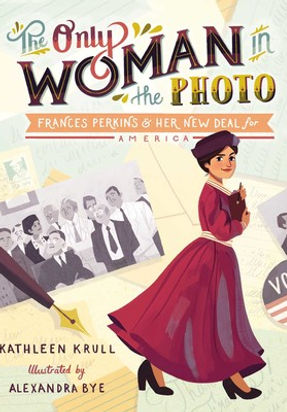THE ONLY WOMAN IN THE PHOTO

I'm sure you know all about President Franklin D. Roosevelt and the New Deal, but do you know anything about his Secretary of Labor Frances Perkins? Born Fannie Coralie Perkins in Boston, Massachusetts on April 10, 1882. As a child Frances was very shy and quiet, but her grandmother always encouraged her to find her voice and challenge herself by saying "when somebody opens a door to you, go forward." In 1908, she moved to New York City and found her voice by becoming heavily involved in the women's suffrage movement and advocating for women's right to vote. Frances later joined the National Consumers League where she pushed for worker's rights and protections along with the elimination of child labor. While working at the Consumers League she visited many businesses, some of which were bakeries where food was being prepared by sick workers in unsanitary conditions including no ventilation and rodent infestation. Frances would document and present her findings to New York City's Board of Health.
On March 25, 1911, Frances was having tea with friends when she heard the firetruck bells near by. She rushed outside and saw a building on fire, it was the Triangle Shirtwaist Factory. She initially thought these were fabric bundles falling out of the windows, but as she got closer she saw they were actually desperate young women and girls, some as young as fourteen years old, jumping one by one from the 10th floor windows to their death.
Frances later discovered that in an effort to prevent theft, the factory owners had locked the doors to the fire escape. The workplace negligence of the factory owners led to 146 young women and girls being killed that day. Frances became an expert investigator and immediately took action and sought ways to prevent future workplace tragedies. Theodore Roosevelt recommended she be named executive secretary of a Committee on Safety. The Committee was instrumental in creating the New York State Factory Investigating Commission, a legislative panel that investigated factories and other workplaces to make sure they were up to code.
In 1929, then New York State Governor Franklin D. Roosevelt appointed her as the Industrial Commissioner of the State of New York to regulate workplaces throughout the state. This made Frances become the highest paid woman to hold public office in the United States at that time. In 1932, newly-elected President Franklin D. Roosevelt asked Frances to serve in his cabinet as Secretary of Labor and help pull the country out of the Great Depression. Frances walked through that open door and forward into history by becoming the first woman U.S. cabinet member.
Many of the modern fire precautions we have today such as fire exits, fire drills, fire extinguishers in glass cases, and water sprinklers began in part because of her.



